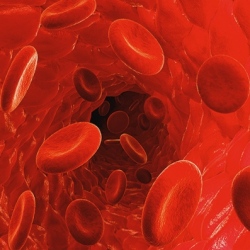
A new hydrogel can be injected to supply one or two different drugs at a time. In theory, gels could be useful for delivering drugs for treating cancer, macular degeneration, or heart disease as they can be molded into shapes and can release their payload in a location. However, current gels are not very practical because they must be implanted surgically.
In contrast, the new gel consists of a mesh network of nanoparticles made of polymers entwined within strands of another polymer, such as cellulose. “Now you have a gel that can change shape when you apply stress to it, and then, importantly, it can re-heal when you relax those forces. That allows you to squeeze it through a syringe or a needle and get it into the body without surgery,” says Mark Tibbitt, a postdoc at MIT’s Koch Institute for Integrative Cancer Research and one of the lead authors of a paper describing the gel in Nature Communications on Thursday Feb. 19.
Koch Institute postdoc Eric Appel is also a lead author of the paper, and the paper’s senior author is Robert Langer, the David H. Koch Institute Professor at MIT. Another limitation of hydrogels for biomedical uses, such as making soft contact lenses, is that they are traditionally formed by irreversible chemical linkages between polymers, so their shape cannot easily be altered.
So the MIT team set out to create a gel that could survive strong mechanical forces, known as shear forces, yet capable of reforming itself. Other researchers have created such gels by engineering proteins that self-assemble into hydrogels, but this approach requires complex biochemical processes. The MIT team wanted to design something simpler.
The MIT approach relies on a combination of two readily available components. One is a type of nanoparticle formed of PEG-PLA copolymers, first developed in Langer’s lab decades ago and now commonly used to package and deliver drugs. To form the new hydrogel, the researchers mixed these particles with a polymer, in this case, cellulose.
Each polymer chain forms weak bonds with many nanoparticles, producing a loosely woven lattice or network of polymers and nanoparticles. Because each attachment point is fairly weak, the bonds are able to break apart under mechanical stress, such as when injected through a syringe. When these shear forces are over, the polymers and nanoparticles reassemble, forming new attachments with different partners and healing the gel.
Using two components to form the gel also gives the researchers the opportunity to deliver two different drugs at the same time. PEG-PLA nanoparticles have an inner core that is ideally suited to carry hydrophobic (water-incompatible) small-molecule drugs, which include many chemotherapy drugs. Meanwhile, the polymers, which exist in a watery solution, can carry hydrophilic (water-compatible) molecules such as proteins, including antibodies and growth factors.
